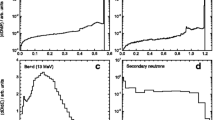Summary
The risk of induction of a second primary cancer after a therapeutic irradiation with conventional photon beams is well recognized and documented. However, in general, it is totally overwhelmed by the benefit of the treatment. The same is true to a large extent for the combinations of radiation and drug therapy.
After fast neutron therapy, the risk of induction of a second cancer is greater than after photon therapy. Neutron RBE increases with decreasing dose and there is a wide evidence that neutron RBE is greater for cancer induction (and for other late effects relevant in radiation protection) than for cell killing. Animal data on RBE for tumor induction are reviewed, as well as other biological effects such as life shortening, malignant cell transformation in vitro, chromosome aberrations, genetic effects. These effects can be related, directly or indirectly, to cancer induction to the extent that they express a “genomic” lesion. almost no reliable human epidemiological data are available so far.
For fission neutrons a RBE for cancer induction of about 20 relative to photons seems to be a reasonable assumption. For fast neutrons, due to the difference in energy spectrum, a RBE of 10 can be assumed.
After proton beam therapy (low-LET radiation), the risk of secondary cancer induction, relative to photons, can be divided by a factor of 3, due to the reduction of integral dose (as an average).
The RBE of heavy-ions for cancer induction can be assumed to be similar to fission neutrons, i. e. about 20 relative to photons. However, after heavy-ion beam therapy, the risk should be divided by 3, as after proton therapy, due to the excellent physical selectivity of the irradiation. Therefore a risk 5 to 10 times higher than photons could be assumed.
This range is probably a pessimistic estimate for carbon ions since most of the normal tissues, at the level of the initial plateau, are irradiated with low-LET radiation.
Similar content being viewed by others
References
Alpen EL. Radiation Biophysics. Second Edition, Academic Press, San Diego, USA, 1998.
Alpen EL, Powers-Risius P, Curtis SB, et al. Tumorigenic potential of high-Z, high-LET charged particle radiations. Radiation Research 1993;136:382–91.
American Association of Physicists in Medicine (AAPM). Total skin electron therapy: technique and dosimetry. Kartzmark CJ (ed.): Report 23. American Institute of Physics, New York, 1987.
Boice JD Jr, Engholm G, Kleinerman RA, et al. Radiation dose and second cancer risk in patients treated for cancer of the cervix. Rad Res 1988;116:3–55.
Broerse JJ, Van Bekkum DW, Zurcher C. Radiation carcinogenesis in experimental animals. Experientia 1989;vol 45:60–9.
Curtis RE, Boice JD Jr, Stovall M, et al. Risk of leukemia after chemotherapy and radiation treatment for breast cancer. New Engl J Med 1992;326:1745–51.
Dicello JF, Wasiolek M, Zaider M. Measured microdosimetric spectra of energetic ion beams of Fe, Ar, Ne and C: Limitations of LET distributions and quality factor in radiation effects and space research. IEEE Trans Nucl Sci 1991;38:1203–9.
Engels H, Wambersie A. Relative biological effectiveness of neutrons for cancer induction and other late effects: a review of radiobiological data, pp. 54–87, in Engenhart-Cabillic R, Wambersie A (eds): Fast neutrons and hig-LET particles in Cancer Research, Vol 150, Springer-Verlag, Berlin-Heidelberg, 1998.
Hall EJ. Neutrons and carcinogenesis: a cautionary tale. In: Breteau N, Le Bourgeois J-P, Barendsen GW, et al. (eds.): Hadrons in radiation therapy. Proceedings of the meeting of the European Heavy Particle Therapy Group, Orléans (France), 4–6 May 1995. Bulletin du Cancer, 1996;83 (suppl 1):43s–6s.
Hollander CF, van Zwieten MJ, Broerse JJ. Carcinogenesis studies in Rhesus monkeys after fission neutron and X-irradiation. In: Broerse JJ, Gerber GB (eds): Neutron Carcinogenesis. Commission of the European Communities. Radiation protection. Report EUR 8084 EN, 1982. Luxembourg, p. 183–185.
International Commission on Radiological Protection (ICRP). 1990 Recommendations of the International Commission on Radiological Protection. ICRP Publication 60. Pergamon Press, Oxford, 1991.
International Commission on Radiological Protection (ICRP). Conversion coefficients for use in radiological protection against external radiation. Report of a Joint Task Group of the International Commission on Radiological Protection (ICRP) and of the International Commisson on Radiation Units and Measurements (ICRU), ICRP Publication 74. Volume 26, Pergamon Press, Oxford, 1996.
International Radiation Study Group on Cervical Cancer. Second cancers in relation to radiation treatment for cervical cancer. Day NE and Boice JD Jr. (eds). IARC Sci Publ 1983;52:1–207.
Karzmark CJ, Nunan S, Tanabe E. Medical electron accelerators. McGraw-Hill, Inc., Health Professions Division, New York, 1993.
Nath R, Epp ER, Laughlin JS, et al. Neutrons from high-energy x-ray medical accelerators: An estimate of risk to the radiotherapy patient. Medical Physics 1984;11:231–41.
Sinclair WK. Experimental RBE values of high LET radiations at low doses and the implications for quality factor assignment. Radiation Protection Dosimetry 1985;13(1–4):319–26.
Tucker MA, Coleman CN, Cox RS, et al. Risk of second cancers after treatment for Hodgkin’s disease. New Engl J Med 1988;318:76–81.
United Nations Scientific Committee on the Effects of Atomic Radiations (UNSCEAR), Ionizing radiation: sources and biological effects. 1982 Report to the General Assembly, with annexes. United Nations, New York, 1982.
Wambersie A. Neutron therapy: from radiobiological expectation to clinical reality. Radiation Protection Dosimetry 1992;44:379–95.
Wambersie A, Gahbauer RA. Medical applications of electron linear accelerators. CERN Accelerator School (CAS), Cyclotrons, linacs and their applications. European organization for Nuclear Research, CERN 96-02, 4 March 1996, pp. 229–48.
Author information
Authors and Affiliations
Rights and permissions
About this article
Cite this article
Engels, H., Menzel, H.G., Pihet, P. et al. Risk assessment for cancer induction after low- and high-LET therapeutic irradiation. Strahlenther Onkol 175 (Suppl 2), 47–51 (1999). https://doi.org/10.1007/BF03038888
Issue Date:
DOI: https://doi.org/10.1007/BF03038888




